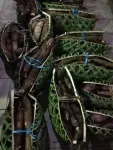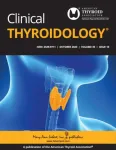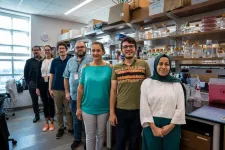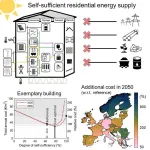(Press-News.org) Images
Nanoengineers have created a quasicrystal—a scientifically intriguing and technologically promising material structure—from nanoparticles using DNA, the molecule that encodes life.
The team, led by researchers at Northwestern University, the University of Michigan and the Center for Cooperative Research in Biomaterials in San Sebastian, Spain, reports the results in Nature Materials.
Unlike ordinary crystals, which are defined by a repeating structure, the patterns in quasicrystals don't repeat. Quasicrystals built from atoms can have exceptional properties—for example, absorbing heat and light differently, exhibiting unusual electronic properties such as conducting electricity without resistance, or their surfaces are very hard or very slippery.
Engineers studying nanoscale assembly often view nanoparticles as a kind of 'designer atom,' which provides a new level of control over synthetic materials. One of the challenges is directing particles to assemble into desired structures with useful qualities, and in building this first DNA-assembled quasicrystal, the team entered a new frontier in nanomaterial design.
"The existence of quasicrystals has been a puzzle for decades, and their discovery appropriately was awarded with a Nobel Prize," said Chad Mirkin, the George B. Rathmann Professor of Chemistry at Northwestern University and co-corresponding author of the study. "Although there are now several known examples, discovered in nature or through serendipitous routes, our research demystifies their formation and more importantly shows how we can harness the programmable nature of DNA to design and assemble quasicrystals deliberately."
Mirkin's group is known for using DNA as a designer glue to engineer the formation of colloidal crystals made of nanoparticles, and the group of Luis Liz-Marzán, the Ikerbasque Professor at the Spanish Center for Cooperative Research in Biomaterials, could produce nanoparticles that might form quasicrystals under the right conditions. The team focused on bipyramidal shapes—basically two pyramids stuck together at their bases. Liz-Marzán's group tried different numbers of sides as well as squashing and stretching the shapes. Wenjie Zhou and Haixin Lin, doctoral students in chemistry at Northwestern at the time of the work, used DNA strands encoded to recognize one another to program the particles to assemble into a quasicrystal.
Independently, the group of Sharon Glotzer, the Anthony C. Lembke Chair of Chemical Engineering at U-M, had been simulating bipyramids with different numbers of sides. Yein Lim and Sangmin Lee, doctoral students in chemical engineering at U-M, found that decahedra—10-sided pentagonal bipyramids—would form a quasicrystal under certain conditions, and with the right relative dimensions.
In 2009, Glotzer's team had predicted the first layered nanoparticle quasicrystal, not from bipyramids but from tetrahedra—single pyramids with four triangular sides like a D4 die. Because five tetrahedra can nearly make a type of decahedron, she says that the decahedron was a savvy choice for making a quasicrystal.
"In our original quasicrystal simulation, the tetrahedra arranged into decahedra with very small gaps between the tetrahedra. Here, those gaps would be filled by DNA, so it made sense that decahedra might make quasicrystals, too," said Glotzer, co-corresponding author of the study.
Through a combination of theory and experiment, the three research groups made the decahedron particles into a quasicrystal, which was confirmed by electron microscope imaging at Northwestern and X-ray scattering done at Argonne National Laboratory.
"Through the successful engineering of colloidal quasicrystals, we have achieved a significant milestone in the realm of nanoscience," said Liz-Marzán, co-corresponding author of the study. "Our work not only sheds light on the design and creation of intricate nanoscale structures but also opens a world of possibilities for advanced materials and innovative nanotechnology applications."
The structure resembles an array of rosettes in concentric circles, the 10-sided shapes creating a 12-fold symmetry in 2D layers that stack periodically. This stacked structure, also seen with quasicrystals made from tetrahedra, is called an axial quasicrystal. But unlike most axial quasicrystals, the tiling pattern of the new quasicrystal's layers do not repeat identically from one layer to the next. Instead, a significant percentage of tiles are different, in a random way—and this small amount of disorder adds stability.
The research is funded by the US Air Force Office of Scientific Research and the US Department of Energy, Spanish Ministry of Science and Innovation, and the Maria de Maeztu Units of Excellence Program from the Spanish State Research Agency. The project also relied on resources at the Extreme Science and Engineering Discovery Environment, NUANCE at Northwestern University and computational resources at U-M.
Glotzer is also the John Werner Cahn Distinguished University Professor of Engineering and Stuart W. Churchill Collegiate Professor of Chemical Engineering.
Study: Colloidal quasicrystals engineered with DNA (DOI: 10.1038/s41563-023-01706-x)
Written in collaboration with Seth Zimmerman
END
Nanoparticle quasicrystal constructed with DNA
The breakthrough opens the way for designing and building more complex structures
2023-11-02
ELSE PRESS RELEASES FROM THIS DATE:
Damaging thunderstorm winds increasing in central U.S.
2023-11-02
Destructive winds that flow out of thunderstorms in the central United States are becoming more widespread with warming temperatures, according to new research by the U.S. National Science Foundation (NSF) National Center for Atmospheric Research (NCAR).
The new study, published this week in Nature Climate Change, shows that the central U.S. experienced a fivefold increase in the geographic area affected by damaging thunderstorm straight line winds in the past 40 years. The research uses a combination of meteorological observations, very high-resolution computer modeling, and analyses of fundamental ...
Climate-induced loss is impeding human rights in the Pacific
2023-11-02
Climate change is impeding the human rights of a large group of people living in the Pacific, a recent report in Nature reveals.
The paper substantiates a submission to the International Court of Justice (ICJ) on the legal responsibility of countries to act on climate change.
Evidence gathered in Vanuatu supports a clarification on loss and damage finance which could activate powerful legal tools to hold polluters accountable.
Research Fellow at the Griffith University Climate Action Beacon, Dr Ross Westoby said the report explores how climate-induced loss and damage in the Pacific is already occurring and outlines ...
Bartering light for light: scientists discover new system to control the chaotic behavior of light
2023-11-02
NEW YORK, November 2, 2023 — Harnessing and controlling light is vital for the development of technology, including energy harvesting, computation, communications, and biomedical sensing. Yet, in real-world scenarios, complexity in light's behavior poses challenges for its efficient control. Physicist Andrea Alù likens the behavior of light in chaotic systems to the initial break shot in a game of billiards.
“In billiards, tiny variations in the way you launch the cue ball will lead to different patterns of the balls bouncing around the table,” said Alù, Einstein ...
Study links changes in global water cycle to higher temperatures
2023-11-02
It’s a multi-billion dollar question: What will happen to water as temperatures continue to rise? There will be winners and losers with any change that redistributes where, when and how much water is available for humans to drink and use.
To find answers and make informed predictions, scientists look to the past. Reconstructions of past climate change using geologic data have helped to show the far-reaching influence of human activity on temperatures since the Industrial Age. But assembling hydroclimate records for the same timeframe has proved to be much harder.
A study from the Past Global Changes (PAGES) Iso2k project team, ...
Metabolite tells cells whether to repair DNA
2023-11-02
Metabolites called nucleotides are the building blocks of DNA and can impact cancer’s sensitivity or resistance to chemotherapy and radiation in brain cancer.
Findings from researchers at the University of Michigan Health Rogel Cancer Center, published in Cancer Discovery, show how a specific nucleotide metabolite, called GTP, controls responses to radiation and chemotherapy in an unexpected way.
“We learned that if you increase a cell’s GTP levels, it makes it really resistant to ...
American Thyroid Association® names Trevor E. Angell, MD new Editor-in-Chief of Clinical Thyroidology®
2023-11-02
The American Thyroid Association® (ATA®) is pleased to announce that Trevor E. Angell, MD has been selected as the new Editor-in-Chief of the ATA monthly journal Clinical Thyroidology®. Dr. Angell’s term as Editor-in-Chief will begin in January 2024.
Clinical Thyroidology is one of the ATA’s official journals and is published in partnership with Mary Ann Liebert, Inc. This highly valued abstract and commentary publication provides a comprehensive look at clinical thyroid literature. Experts ...
Hollings researchers uncover new targets for breast cancers resistant to standard therapies
2023-11-02
Researchers at MUSC Hollings Cancer Center believe that some drugs already approved by the U.S. Food and Drug Administration or currently in clinical trials could be repurposed for certain breast cancer patients whose cancer has become resistant to standard therapies.
Ozgur Sahin, Ph.D., a professor and SmartState Endowed Chair in the Department of Biochemistry and Molecular Biology, led the research, which was published Nov. 2 in Nature Communications.
The research, funded by an American Cancer Society Research Scholar Grant, started as an investigation into cancer resistance to the drug tamoxifen but expanded as the research questions led down new ...
Start-up dedicated to developing new antibiotics
2023-11-02
It all began with basic research: While conducting laboratory experiments, a team at the Technical University of Munich (TUM) came across an active agent against multidrug-resistant bacteria with a fundamental difference to antibiotics developed to date. The researchers have since established a start-up to develop a new drug based on this agent. The entrepreneurs have now been nominated for Science Breakthrough of the Year in the Science Start-Up category at the international Falling Walls summit.
Rising numbers of bacteria are developing ...
Two million European households could abandon the electrical grid by 2050
2023-11-02
Researchers report that 53% of European freestanding homes could have supplied all their own energy needs in 2020 using only local rooftop solar radiation, and this technical feasibility could increase to 75% in 2050. Publishing November 2 in the journal Joule, the study shows that there is no economic advantage for individual households to be fully self-sufficient under current or future conditions, though in some cases the costs are on par with remaining on-grid. The researchers estimate that self-sufficiency will be economically feasible for 5% (two million) of Europe’s 41 million freestanding single-family homes in 2050, ...
One sleepless night can rapidly reverse depression for several days
2023-11-02
All-nighters can cause giddy and slap-happy feelings
This effect is caused by increased dopamine release in distributed brain regions
This dopamine signal also enhances plasticity in the neuronal connections, causing a potent antidepressant effect that lasts for days
Study suggests that prefrontal cortex and its dopamine inputs are key for rapid plasticity and antidepressant effects after brief sleep loss
EVANSTON, Ill. — Most people who have pulled an all-nighter are all too familiar with that “tired and wired” ...
LAST 30 PRESS RELEASES:
B cells transiently unlock their plasticity, risking lymphoma development
Advanced AI dodel predicts spoken language outcomes in deaf children after cochlear implants
Multimodal imaging-based cerebral blood flow prediction model development in simulated microgravity
Accelerated streaming subgraph matching framework is faster, more robust, and scalable
Gestational diabetes rose every year in the US since 2016
OHSU researchers find breast cancer drug boosts leukemia treatment
Fear and medical misinformation regarding risk of progression or recurrence among patients with breast cancer
Glucagonlike peptide-1 receptor agonists and asthma risk in adolescents with obesity
Reviving dormant immunity: Millimeter waves reprogram the immunosuppressive microenvironment to potentiate immunotherapy without obvious side effects
Safety decision-making for autonomous vehicles integrating passenger physiological states by fNIRS
Fires could emit more air pollution than previously estimated
A new way to map how cells choose their fate
Numbers in our sights affect how we perceive space
SIMJ announces global collaborative book project in commemoration of its 75th anniversary
Air pollution exposure and birth weight
Obstructive sleep apnea risk and mental health conditions among older adults
How talking slows eye movements behind the wheel
The Ceramic Society of Japan’s Oxoate Ceramics Research Association launches new international book project
Heart-brain connection: international study reveals the role of the vagus nerve in keeping the heart young
Researchers identify Rb1 as a predictive biomarker for a new therapeutic strategy in some breast cancers
Survey reveals ethical gaps slowing AI adoption in pediatric surgery
Stimulant ADHD medications work differently than thought
AI overestimates how smart people are, according to HSE economists
HSE researchers create genome-wide map of quadruplexes
Scientists boost cell "powerhouses" to burn more calories
Automatic label checking: The missing step in making reliable medical AI
Low daily alcohol intake linked to 50% heightened mouth cancer risk in India
American Meteorological Society announces Rick Spinrad as 2026 President-Elect
Biomass-based carbon capture spotlighted in newly released global climate webinar recording
Illuminating invisible nano pollutants: advanced bioimaging tracks the full journey of emerging nanoscale contaminants in living systems
[Press-News.org] Nanoparticle quasicrystal constructed with DNAThe breakthrough opens the way for designing and building more complex structures




